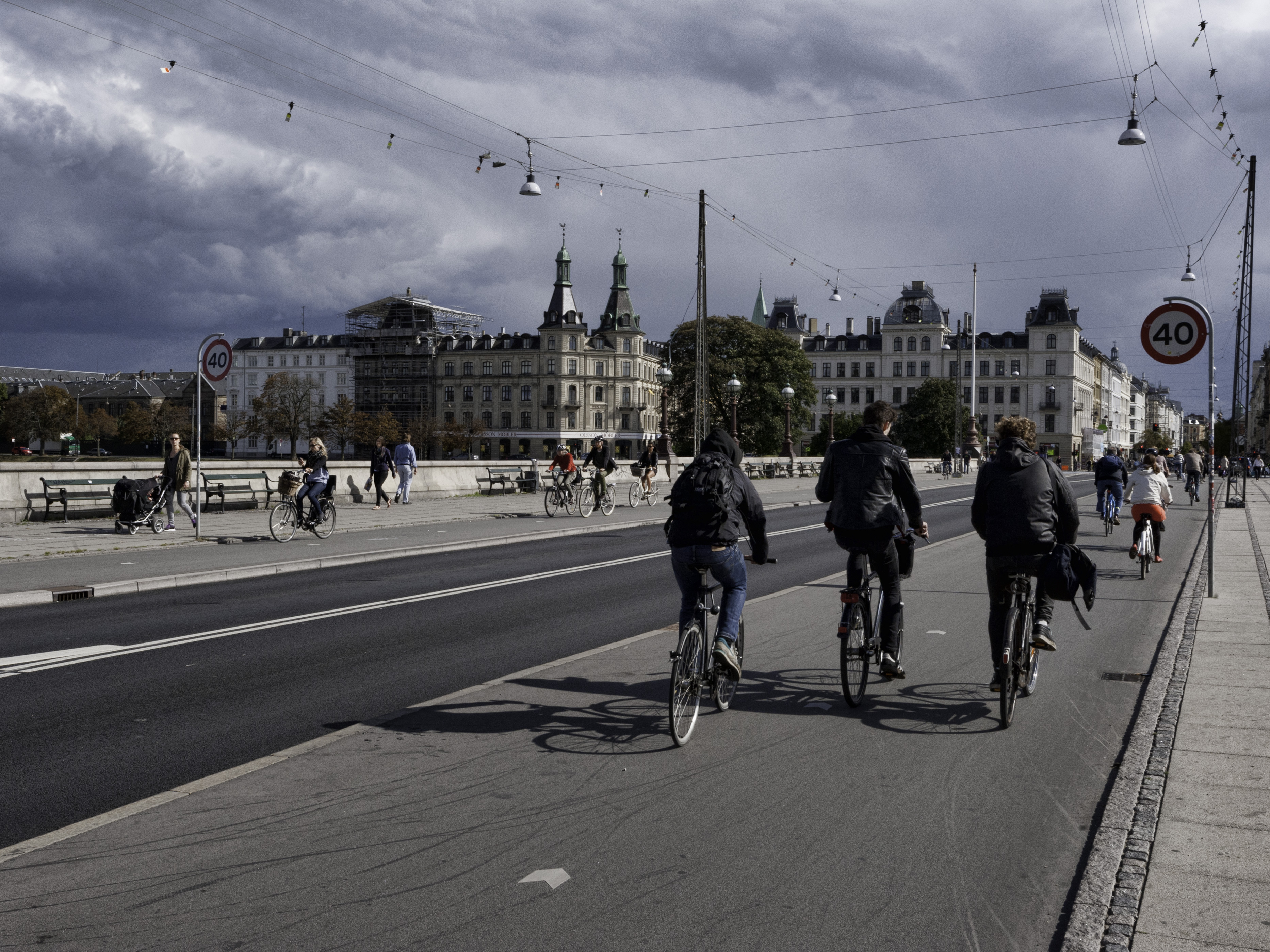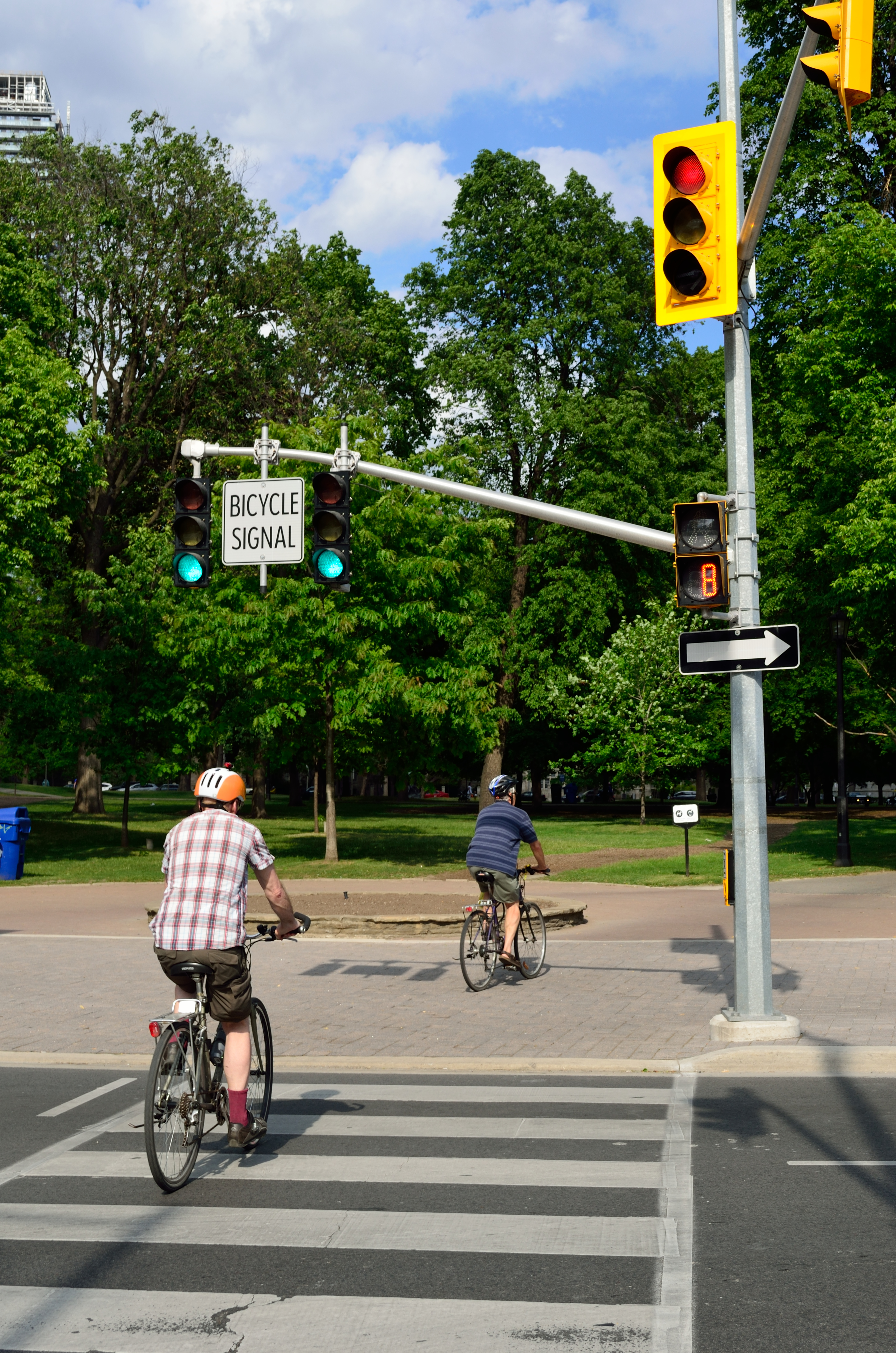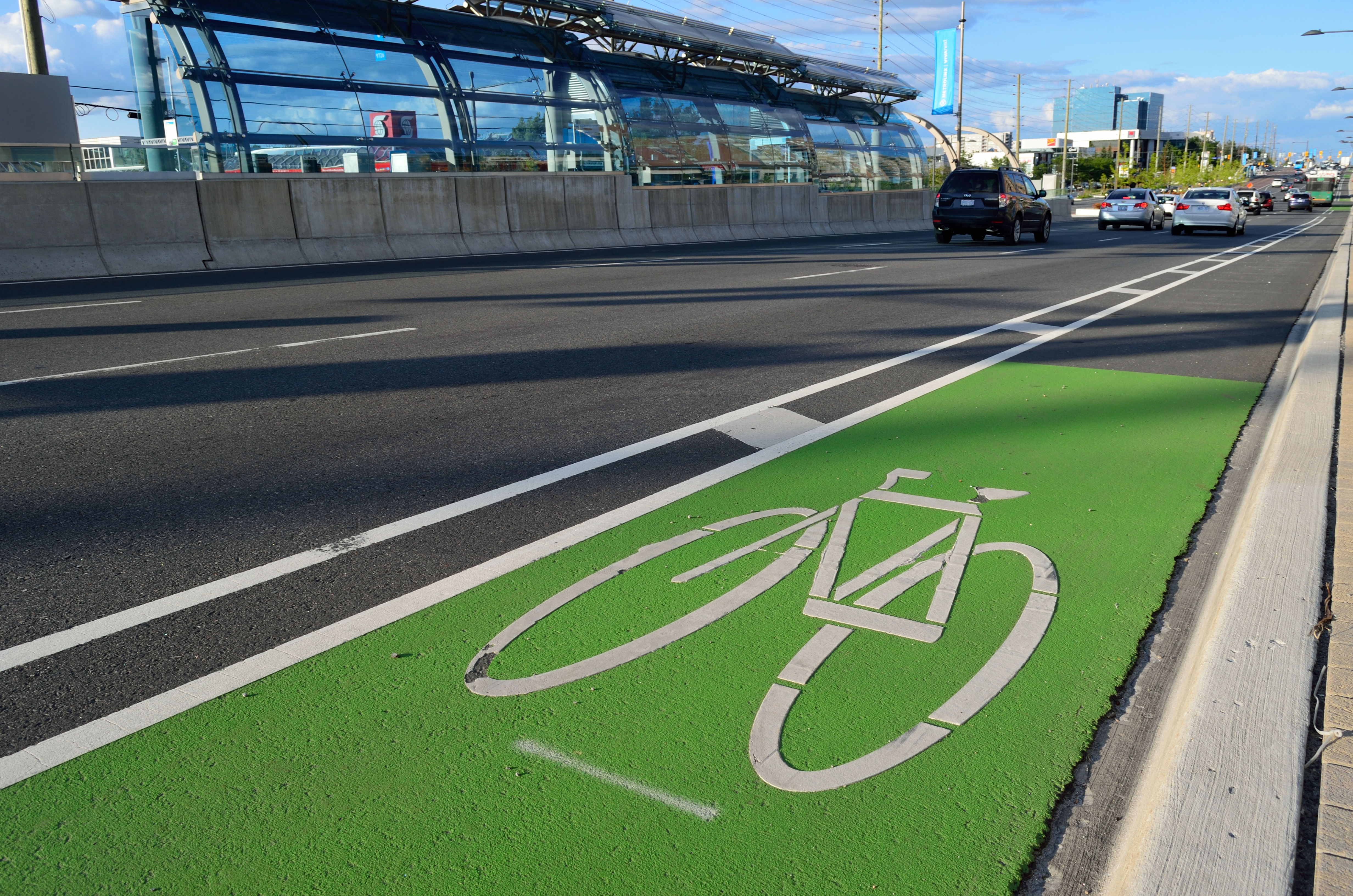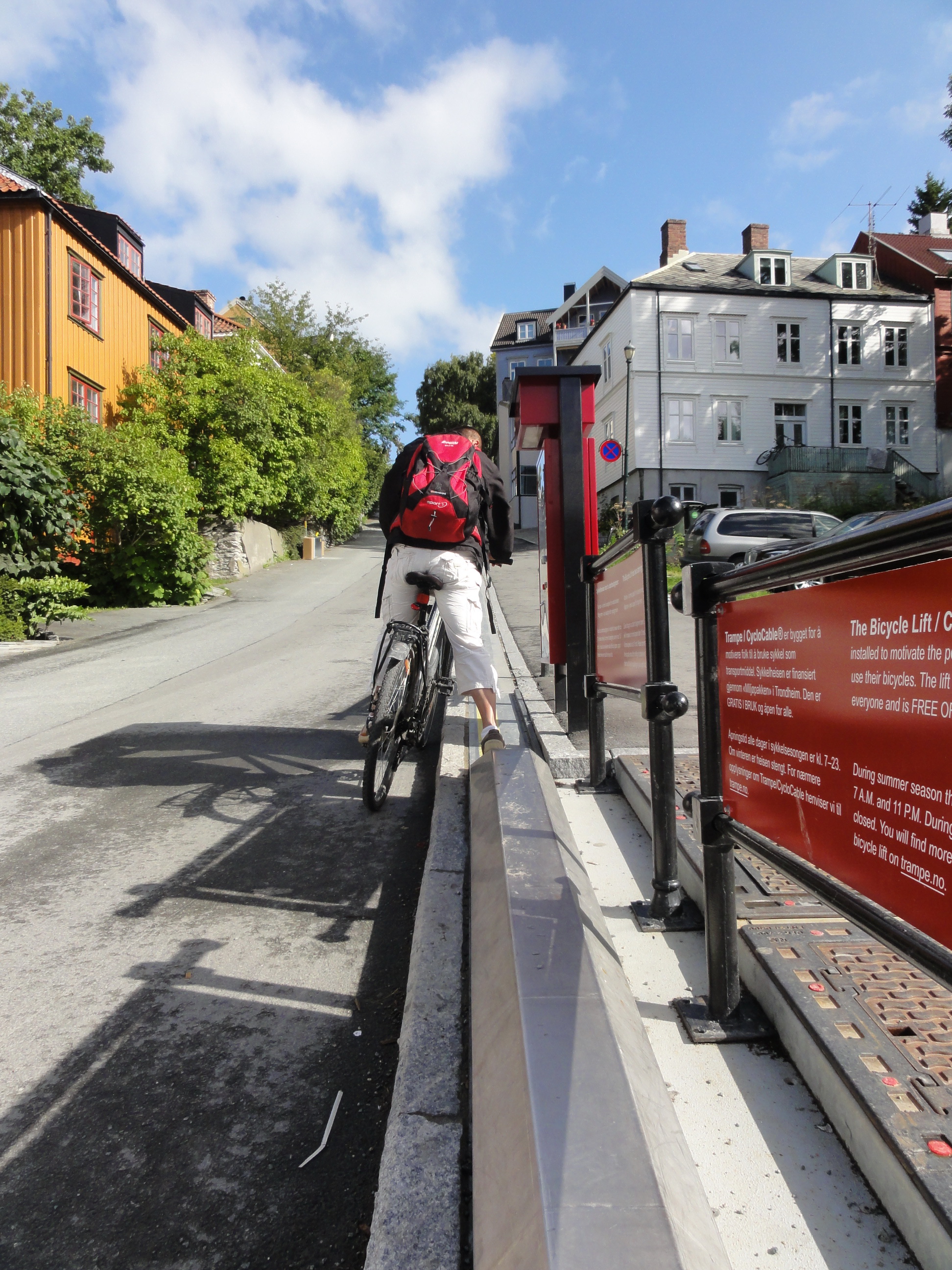

 Cycling infrastructure is all
Cycling infrastructure is all  Good road design, road maintenance and traffic management can make cycling safer and more useful. Settlements with a dense network of interconnected streets tend to be places for getting around by bike. Their cycling networks can give people direct, fast, easy and convenient routes.
Good road design, road maintenance and traffic management can make cycling safer and more useful. Settlements with a dense network of interconnected streets tend to be places for getting around by bike. Their cycling networks can give people direct, fast, easy and convenient routes.
History
The history of cycling infrastructure starts from shortly after the bike boom of the 1880s when the first short stretches of dedicated bicycle infrastructure were built, through to the rise of the automobile from the mid-20th century onwards and the concomitant decline of cycling as a means of transport, to cycling's comeback from the 1970s onwards.Bikeways
A bikeway is a lane, route, way or path which in some manner is specifically designed and /or designated forTerms
Some bikeways are separated from motor traffic by physical constraints (e.g. barriers, parking or bollards)— bicycle trail, cycle track—but others are partially separated only by painted markings— bike lane, buffered bike lane, and contraflow bike lane. Some share the roadway with motor vehicles— bicycle boulevard, sharrow, advisory bike lane—or shared with pedestrians— shared use paths and greenways.Segregation
The term bikeway is largely used in North America to describe all routes that have been designed or updated to encourage more cycling or make cycling safer. In some jurisdictions such as the United Kingdom, ''segregated cycling facility'' is sometimes preferred to describe cycling infrastructure which has varying degrees of separation from motorized traffic, or which has excluded pedestrian traffic in the case of exclusive bike paths. There is no single usage of ''segregation''; in some cases it can mean the exclusion of motor vehicles and in other cases the exclusion of pedestrians as well. Thus, it includes bike lanes with solid painted lines but not lanes with dotted lines and advisory bike lanes where motor vehicles are allowed to encroach on the lane. It includes cycle tracks as physically distinct from the roadway and sidewalk (e.g. barriers, parking or bollards). And it includesSafety
On major roads, segregated cycle tracks lead to safety improvements compared with cycling in traffic. There are concerns over the safety of cycle tracks and lanes at junctions due to collisions between turning motorists and cyclists, particularly where cycle tracks are two-way.http://vbn.aau.dk/files/14344951/agerholm_et_al._bicycle_paths.pdf The safety of cycle tracks at junctions can be improved with designs such as cycle path deflection (between 2m and 5m) andLegislation
Different countries have different ways to legally define and enforce bikeways.Bikeway controversies
Some detractors argue that one must be careful in interpreting the operation of dedicated or segregated bikeways/cycle facilities across different designs and contexts; what works for the Netherlands will not necessarily work elsewhere, or claiming that bikeways increase urban air pollution. Other transportation planners consider an incremental, piecemeal approach to bike infrastructure buildout ineffective and advocate for complete networks to be built in a single phase. Proponents point out that cycling infrastructure including dedicated bike lanes has been implemented in many cities; when well-designed and well-implemented they are popular and safe, and they are effective at relieving both congestion and air pollution.Bikeway selection
Jurisdictions have guidelines around the selection of the right bikeway treatments in order make routes more comfortable and safer for cycling. A study reviewing the safety of " road diets" (motor traffic lane restrictions) for bike lanes found in summary that crash frequencies at road diets in the period after installation were 6% lower, road diets do not affect crash severity, or result in a significant change in crash types. This research was conducted by looking at areas scheduled for conversion before and after the road diet was performed. While also comparing similar areas that had not received any changes. It is noted that further research is recommended to confirm findings.Bikeway types
Bikeways can fall into these main categories: separated in-roadway bikeways such as bike lanes and buffered bike lanes; physically separated in-roadway bikeways such as cycle tracks; right-of-way paths such as bike paths and shared use paths; and shared in-roadway bikeways such as bike boulevards, shared lane markings, and advisory bike lanes. The exact categorization changes depending on the jurisdiction and organization, while many just list the types by their commonly used namesDedicated bikeways
Sharing with motor traffic
Cyclists are legally allowed to travel on many roadways in accordance with the rules of the road for drivers of vehicles. A bicycle boulevard or cycle street is a low speed street which has been optimized for bicycle traffic. Bicycle boulevards discourage cut-through motor vehicle traffic but allow local motor vehicle traffic. They are designed to give priority to cyclists as through-going traffic.
A
A bicycle boulevard or cycle street is a low speed street which has been optimized for bicycle traffic. Bicycle boulevards discourage cut-through motor vehicle traffic but allow local motor vehicle traffic. They are designed to give priority to cyclists as through-going traffic.
A Bicycle highways
Denmark and the Netherlands have pioneered the concept of "bicycle superhighways". The first Dutch route opened in 2004 between Breda and Etten-Leur; many others have been added since then. In 2017 several bicycle superhighways were opened in the Arnhem-Nijmegen region, with the RijnWaalpad as the best example of this new type of cycling infrastructure. The first Danish route, C99, opened in 2012 between the Vesterbro rail station in Copenhagen and Albertslund, a western suburb. The route cost 13.4 million DKK and is 17.5 km long, built with few stops and new paths away from traffic. "Service stations" with air pumps are located at regular intervals, and where the route must cross streets, handholds and running boards are provided so cyclists can wait without having to put their feet on the ground. Similar projects have since been built in Germany among other countries. The cost of building a bicycle super highway depends on many things, but is usually between €300000/km (for a wide dedicated cycle track) and €800000/km (when complex civil engineering structures are needed).Cycling-friendly streetscape modifications
, Institution of Highways and Transportation, Cyclists Touring Club, 1996. Colombian city, Bogota converted some car lanes into bidirectional bike lanes during coronavirus pandemic, adding 84 km of new bike lanes; the government is intending to make these new bike lanes permanent. In the US, slow-street movements have been introduced by erecting makeshift barriers to slow traffic and allow bikers and walkers to safely share the road with motorists.
Traffic reduction
Removing traffic can be achieved by straightforward diversion or alternatively reduction. Diversion involves routing through-traffic away from roads used by high numbers of cyclists and pedestrians. Examples of diversion include the construction of arterial bypasses and ring roads around urban centres. Indirect methods involve reducing the infrastructural capacity dedicated to moving motorized vehicles. This can involve reducing the number of road lanes, closing bridges to certain vehicle types and creatingTraffic calming
Speed reduction has traditionally been attempted by statutory speed limits and enforcing the assured clear distance ahead rule. Recent implementations of shared space schemes have delivered significant traffic speed reductions. The reductions are sustainable, without the need for speed limits or speed limit enforcement. InOne-way streets
German research indicates that making one-way streets two-way for cyclists results in a reduction in the total number of collisions. In Belgium, all one-way streets in 50 km/h zones are by default two-way for cyclists. A Danish road directorate states that in town centres it is important to be able to cycle in both directions in all streets, and that in certain circumstances, two-way cycle traffic can be accommodated in an otherwise one-way street.Two-way cycling on one-way streets
One-way street systems can be viewed as either a product of traffic management that focuses on trying to keep motorized vehicles moving regardless of the social and other impacts, such as by some cycling campaigners, or seen as a useful tool for traffic calming, and for eliminating rat runs, in the view of UK traffic planners. One-way streets can disadvantage cyclists by increasing trip-length, delays and hazards associated with weaving maneuvers at junctions. In northern European countries such as the Netherlands, however, cyclists are frequently granted exemptions from one-way street restrictions, which improves cycling traffic flow while restricting motorized vehicles. German research indicates that making one-way streets two-way for cyclists results in a reduction in the total number of collisions. There are often restrictions to what one-way streets are good candidates for allowing two-way cycling traffic. In Belgium road authorities in principle allow any one-way street in zones to be two-way for cyclists if the available lane is at least wide (area free from parking) and no specific local circumstances prevent it. Denmark, a country with high cycling levels, does not use one-way systems to improve traffic flow.Collection of Cycle Concepts, Danish Roads Directorate, Copenhagen, 2000 Some commentators argue that the initial goal should be to dismantle large one-way street systems as a traffic calming/traffic reduction measure, followed by the provision of two-way cyclist access on any one-way streets that remain.
, Dublin Cycling Campaign (Accessed 2007-01-27)
Intersection/Junction design
In general, junction designs that favour higher-speed turning, weaving and merging movements by motorists tend to be hostile for cyclists. Free-flowing arrangements can be hazardous for cyclists and should be avoided. Features such as large entry curvature, slip-roads and high flow roundabouts are associated with increased risk of car–cyclist collisions.Layout and Design Factors Affecting Cycle Safety at T-Junctions, Henson R. and Whelan N., Traffic Engineering and Control, October 1992Pedal cyclists at dual carriage-way slip roads, M.C. Williams and R.E. Layfield, Traffic Engineering and Control, pp. 597-600, November, 1987 Cycling advocates argue for modifications and alternative junction types that resolve these issues such as reducing kerb radii on street corners, eliminating slip roads and replacing large roundabouts with signalized intersections.Protected intersection
Another approach which the Netherlands innovated is called in North America a protected intersection that reconfigures intersections to reduce risk to cyclists as they cross or turn. Some American cities are starting to pilot protected intersections.Bike box
A bike box or an advanced stop line is a designated area at the head of a traffic lane at a signalized intersection that provides bicyclists with a safer and more visible way to get ahead of queuing traffic during the red signal phase.Roundabouts
 On large roundabouts of the design typically used in the UK and Ireland, cyclists have an injury accident rate that is 14-16 times that of motorists. Research indicates that excessive sightlines at uncontrolled intersections compound these effects. In the UK, a survey of over 8,000 highly experienced and mainly adult male Cyclists Touring Club members found that 28% avoided roundabouts on their regular journey if at all possible. The Dutch CROW guidelines recommend roundabouts only for intersections with motorized traffic up to 1500 per hour. In order to accommodate greater volumes of traffic, they recommend traffic light intersections or grade separation for cyclists. Examples of grade separation for cyclists include tunnels, or more spectacularly, raised "floating" roundabouts for cyclists.
On large roundabouts of the design typically used in the UK and Ireland, cyclists have an injury accident rate that is 14-16 times that of motorists. Research indicates that excessive sightlines at uncontrolled intersections compound these effects. In the UK, a survey of over 8,000 highly experienced and mainly adult male Cyclists Touring Club members found that 28% avoided roundabouts on their regular journey if at all possible. The Dutch CROW guidelines recommend roundabouts only for intersections with motorized traffic up to 1500 per hour. In order to accommodate greater volumes of traffic, they recommend traffic light intersections or grade separation for cyclists. Examples of grade separation for cyclists include tunnels, or more spectacularly, raised "floating" roundabouts for cyclists.
Traffic signals/Traffic control systems
How traffic signals are designed and implemented directly impacts cyclists.Priority for cycling in an urban traffic control system, Stephen D. Clark, Matthew W. Page, Institute for Transport Studies, University of Leeds, Velomondial Conference Proceedings, Amsterdam 2000 For instance, poorly adjusted vehicle detector systems, used to trigger signal changes, may not correctly detect cyclists. This can leave cyclists in the position of having to "run" red lights if no motorized vehicle arrives to trigger a signal change. Some cities use urban adaptive traffic control systems (UTCs), which use linked traffic signals to manage traffic in response to changes in demand. There is an argument that using a UTC system merely to provide for increased capacity for motor traffic will simply drive growth in such traffic.Assessing the Impact of Local Transport Policy Instruments Susan Grant-Muller (Editor), it is Working Paper 549, Institute of Transport Studies, Leeds University, April 2000 However, there are more direct negative impacts. For instance, where signals are arranged to provide motor traffic with so-called green waves, this can create "red waves" for other road users such as cyclists and public transport services. Traffic managers in Copenhagen have now turned this approach on its head and are linking cyclist-specific traffic signals on a major arterial bike lane to provide green waves for rush hour cycle-traffic. However, this would still not resolve the problem of red-waves for slow (old and young) and fast (above average fitness) cyclists. Cycling-specific measures that can be applied at traffic signals include the use of advanced stop lines and/or bypasses. In some cases cyclists might be given a free-turn or a signal bypass if turning into a road on the nearside.
Signposting
In many places worldwide special signposts for bicycles are used to indicate directions and distances to destinations for cyclists. Apart from signposting in and between urban areas, mountain pass cycling milestones have become an important service for bicycle tourists. They provide cyclists with information about their current position with regard to the summit of theWidening outside lanes
One method for reducing potential friction between cyclists and motorized vehicles is to provide "wide kerb", or "nearside", lanes (UK terminology) or " wide outside through lane" (U.S. terminology). These extra-wide lanes increase the probability that motorists pass cyclists at a safe distance without having to change lanes. This is held to be particularly important on routes with a high proportion of wide vehicles such as The use of such lanes is specifically endorsed by ''Cycling: the way ahead for towns and cities'', the European Commission policy document on cycle promotion.Cycling: the way ahead for towns and cities
The use of such lanes is specifically endorsed by ''Cycling: the way ahead for towns and cities'', the European Commission policy document on cycle promotion.Cycling: the way ahead for towns and cities, European Commission, 1999
Shared space
 Shared space schemes extend this principle further by removing the reliance on lane markings altogether, and also removing road signs and signals, allowing all road users to use any part of the road, and giving all road users equal priority and equal responsibility for each other's safety. Experiences where these schemes are in use show that road users, particularly motorists, undirected by signs, kerbs, or road markings, reduce their speed and establish eye contact with other users. Results from the thousands of such implementations worldwide all show casualty reductions and most also show reduced journey times. After the partial conversion of London's
Shared space schemes extend this principle further by removing the reliance on lane markings altogether, and also removing road signs and signals, allowing all road users to use any part of the road, and giving all road users equal priority and equal responsibility for each other's safety. Experiences where these schemes are in use show that road users, particularly motorists, undirected by signs, kerbs, or road markings, reduce their speed and establish eye contact with other users. Results from the thousands of such implementations worldwide all show casualty reductions and most also show reduced journey times. After the partial conversion of London's  ''CFI'' argues for a marked lane width of . On undivided roads, width provides cyclists with adequate clearance from passing HGVs while being narrow enough to deter drivers from "doubling up" to form two lanes. This "doubling up" effect may be related to junctions. At non-junction locations, greater width might be preferable if this effect can be avoided. The European Commission specifically endorses wide lanes in its policy document on cycling promotion, ''Cycling: the way ahead for towns and cities''.
''CFI'' argues for a marked lane width of . On undivided roads, width provides cyclists with adequate clearance from passing HGVs while being narrow enough to deter drivers from "doubling up" to form two lanes. This "doubling up" effect may be related to junctions. At non-junction locations, greater width might be preferable if this effect can be avoided. The European Commission specifically endorses wide lanes in its policy document on cycling promotion, ''Cycling: the way ahead for towns and cities''.
Shared bus and cycle lanes
Shared bus and cycle lanes are also a method for providing a more comfortable and safer space for cyclists. Depending on the width of the lane, the speeds and number of buses, and other local factors, the safety and popularity of this arrangement vary. In the Netherlands mixed bus/cycle lanes are uncommon. According to the Sustainable Safety guidelines they would violate the principle of homogeneity and put road users of very different masses and speed behaviour into the same lane, which is generally discouraged.Road surface
Bicycle tires being narrow, road surface is more important than for other transport, for both comfort and safety. The type and placement of storm drains, manholes, surface markings, and the general road surface quality should all be taken into account by a bicycle transportation engineer. Drain grates, for example, must not catch wheels.Trip-end facilities
Bicycle parking/storage arrangements

 As secure and convenient bicycle parking is a key factor in influencing a person's decision to cycle, decent parking infrastructure must be provided to encourage the uptake of cycling. Decent bicycle parking involves weather-proof infrastructure such as
As secure and convenient bicycle parking is a key factor in influencing a person's decision to cycle, decent parking infrastructure must be provided to encourage the uptake of cycling. Decent bicycle parking involves weather-proof infrastructure such as Other trip end facilities
Some people need to wear special clothes such as business suits or uniforms in their daily work. In some cases the nature of the cycling infrastructure and the prevailing weather conditions may make it very hard to both cycle and maintain the work clothes in a presentable condition. It is argued that such workers can be encouraged to cycle by providing lockers, changing rooms and shower facilities where they can change before starting work.Theft reduction measures
The theft of bicycles is one of the major problems that slow the development of urban cycling. Bicycle theft discourages regular cyclists from buying new bicycles, as well as putting off people who might want to invest in a bicycle. Several measures can help reduce bicycle theft: * Bicycle registration to enable recovery if stolen * Making cyclists aware of antitheft devices and their effective use * MountingBicycle lift
 Bicycle lifts are used to haul bikes up stairs and steep hills. They are used to improve accessibility and encourage casual cycling.
Bike escalators are widely used in East Asia and are used in parts of Europe.
Bicycle lifts are used to haul bikes up stairs and steep hills. They are used to improve accessibility and encourage casual cycling.
Bike escalators are widely used in East Asia and are used in parts of Europe.
Impact
According to a 2019 study, protected and separated bike infrastructure is associated with greater safety outcomes for all road users. A 2021 review of existing research found that closing car lanes and replacing them with bike lanes or pedestrian lanes had positive or non-significant economic effects. A 2021 case-control study of cities found that redistributingIntegration with public transit
 Cycling is often integrated with other transport. For example, in the Netherlands and Denmark a large number of train journeys may start by bicycle. In 1991, 44% of Dutch train travelers went to their local station by bicycle and 14% used a bicycle at their destinations. The key ingredients for this are claimed to be:
* an efficient, attractive and affordable train service
* secure bike parking at train stations
* a quick and easy bicycle rental system for commuters, the OV-bicycle scheme, at train stations
* a town planning policy that results in a sufficient proportion of the potential commuter population (e.g. 44%) living/working within a reasonable cycling distance of the train stations.
It has been argued in relation to this aspect of Dutch or Danish policy that ongoing investment in rail services is vital to maintaining their levels of cycle use.
Cycling and public transport are well integrated in Japan. Starting in 1978, Japan expanded bicycle parking supply at railway stations from 598,000 spaces in 1977 to 2,382,000 spaces in 1987. As of 1987, Japanese provisions included 516 multi-story garages for bicycle parking.Bicycle Access to Public Transportation: Learning from Abroad by Michael Replogle, Journal of the Institute for Transportation Engineers, December 1992
In January 2007, the European parliament adopted a motion decreeing that all international trains must carry bicycles. In some cities, bicycles may also be carried on local trains, trams and
Cycling is often integrated with other transport. For example, in the Netherlands and Denmark a large number of train journeys may start by bicycle. In 1991, 44% of Dutch train travelers went to their local station by bicycle and 14% used a bicycle at their destinations. The key ingredients for this are claimed to be:
* an efficient, attractive and affordable train service
* secure bike parking at train stations
* a quick and easy bicycle rental system for commuters, the OV-bicycle scheme, at train stations
* a town planning policy that results in a sufficient proportion of the potential commuter population (e.g. 44%) living/working within a reasonable cycling distance of the train stations.
It has been argued in relation to this aspect of Dutch or Danish policy that ongoing investment in rail services is vital to maintaining their levels of cycle use.
Cycling and public transport are well integrated in Japan. Starting in 1978, Japan expanded bicycle parking supply at railway stations from 598,000 spaces in 1977 to 2,382,000 spaces in 1987. As of 1987, Japanese provisions included 516 multi-story garages for bicycle parking.Bicycle Access to Public Transportation: Learning from Abroad by Michael Replogle, Journal of the Institute for Transportation Engineers, December 1992
In January 2007, the European parliament adopted a motion decreeing that all international trains must carry bicycles. In some cities, bicycles may also be carried on local trains, trams and Bikesharing systems
A bicycle sharing system, public bicycle system, or bike share scheme, is a service in which bicycles are made available for shared use to individuals on a very short-term basis. Bike share schemes allow people to borrow a bike from point "A" and return it at point "B". Many of the bicycle sharing systems are on a subscription basis.Examples of cycling infrastructure
See also
* Bicycle bridge * * Bicycle stairway * * * * * * : frees up space for bicycle lanes * Organizing bodies: * * Muli-modal road safety: *References
External links
Bicycle Infrastructure Manuals
a compendium of infrastructure design manuals, cycling master plans and strategy guides
Urban Bikeway Design Guide
from National Association of City Transportation Officials
Bicycle infrastructure in the Netherlands
video and blog explaining the Dutch approach of addressing cycling infrastructure safety
CyclOSM
an
Opencyclemap
are global maps of cycling infrastructure
Bicycle Facilities
is a world map and statistics of cycling infrastructure {{Authority control Transport infrastructure